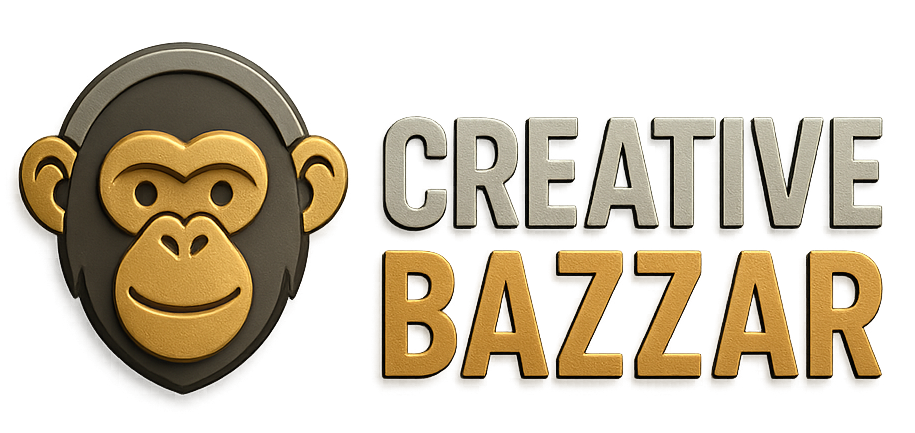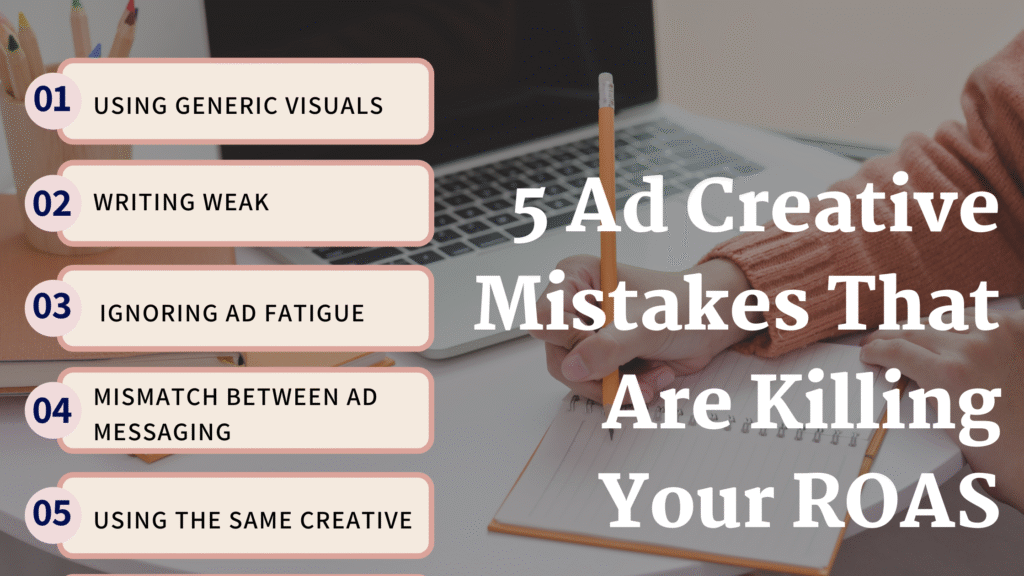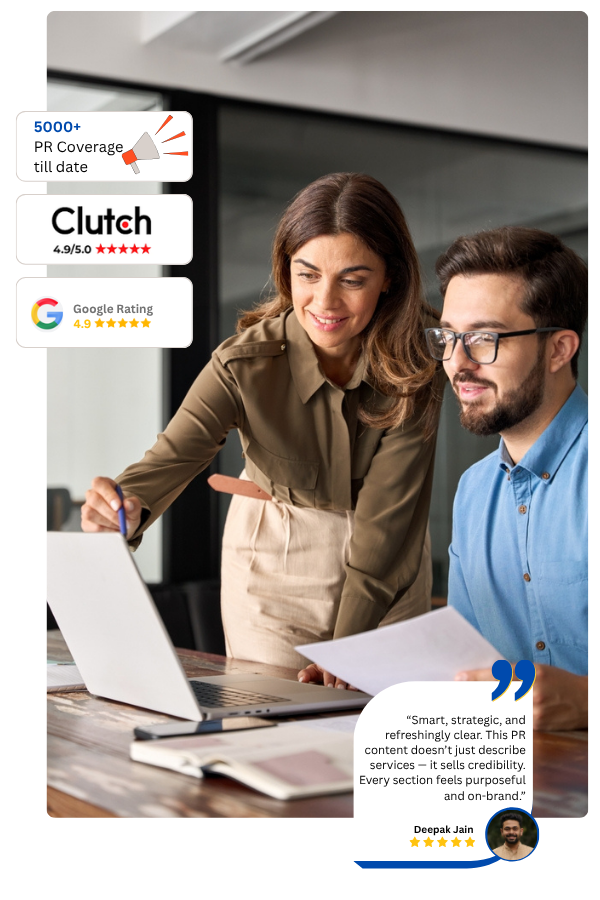Advertising in today’s digital-driven world is a make or break in growing your brand on the internet. Marketers devote thousands of dollars (and even millions) to digital marketing services, expecting their ad spend to receive high ROAS. Nonetheless, sometimes with the right target audience, strategic budget, noise, and so on, all the campaigns fail because of the factor that is often overlooked in marketing, and this is a bad ad creatives.
The first thing that potential customers see is your ad creative. Without compelling, the best PPC campaigns or the social media marketing strategies will fail to bring the desired results. Small business or a global brand, eliminating these five mistakes of creativity will help your advertising run much better and send your ROAS skyrocketing.
1. Using Generic Visuals That Don’t Capture Attention
Online advertising relies heavily on a powerful image. However, most brands use stock images, or templates that do not draw attention in a competitive advertising channel such as Instagram, Facebook, or Google Display Network. People can just scroll endlessly and be distracted all the time by digital intrusions, so simple visuals are just going unnoticed.
This error has a direct implication on your performance marketing statistics. Poor quality or exhausted imagery lowers interactivity, lowers your click-through rate (CTR) and raises your cost-per-click (CPC). Even worse, they may give a bad first impression, which hurts brand perception.
To curb this get custom tailored creative works of digital advertisements that are bold, brand-specific and audience based. Make it have an emotional appeal or connection through use of eye-catching colours, real people, product demonstrations or user created content. Top-level visuals do not only drive engagement but also contribute to brand recollection which is another critical aspect of successful long-term digital marketing.
2. Writing Weak or Vague Ad Copy
In digital marketing, images can attract attention-it is ad copy writing that closes the deal. The unfortunate thing is that some brands have the habit of employing weak, generic or vague copy that does not spell out the value of their offer. Vague, urgent, or irrelevant copy should not cause people to act because that is a wasted opportunity.
This is a problem that impacts upon your conversion rate optimization. The customer experience is disrupted by bad headlines, unclear messages, or mixed up calls to action. Your copy should be persuasive and straight to the point regardless of whether you are advertising an eBook, a discount or a service.
The good ad copy believes in benefits rather than features, appeals to the user’s emotions and says a lot in an obscure few lines. Send CTAs such as Start Your Free Trial, Book a Demo Today, or Unlock Your Offer to help the audience to take the next step. The trick is to coordinate copy to go with your visuals (as well as your landing page) to create an affable and convincing experience.
3. Ignoring Ad Fatigue and Failing to Refresh Creatives
A regular rotation of creative materials is one of the critical characteristics of social media advertising and one of the most widespread yet cost-breakers. Otherwise, when your readers continue to observe the repetition of the same image and message they will switch off. It is referred to as ad fatigue and causes CTRs to decrease, CPAs to increase, and the ROI to contract.
This problem is particular in Facebook and Instagram advertising, the efficiency of which is directly connected with constant presence. Using the same creative repeatedly for too long will not just leave your audience bored but also give ad platforms an indication that your material is not relevant anymore and this means more costs.
The fix is positive creative rotation. Generate a plan to have your digital ad creatives refreshed on a weekly basis of 10-14 days depending on the size of audience and the goals of the campaigns. Switch image formats, create new headlines, add video and vary them through A/B Testing. At Creative Bazzar, we work with clients to create a vibrant creative library to prevent fatigues and increase long term performance of the campaigns.
4. Mismatch Between Ad Messaging and Landing Page Experience
Your advertisement can be very good but in the event that it does not fit the landing page with the promise in the ad, you can lose the client within the first few seconds. This disconnect is among the greatest contributors of low conversion rate optimization outcomes. Lack of consistency in the delivery of messages to users causes confusion, trust violation, and bounce rates.
For example, you may have an ad that says there is 50% off today and this is only today; however, when someone clicks on the link and arrives at a landing page, they can see it is not mentioned anywhere, they will leave the page instantly. In a like manner, when the visual tone of the ad and the tone and the brands differ, the user experience is jolted out of tune.
The solution to this is to implement best practices on landing page optimization. Make sure there are message matches between the ad and landing page, avoid changing order of CTAs and create the same visual tone. These factors also enhance the conversion rates and aid in achieving improved digital advertising outcomes because of fast loading time, mobile responsiveness, and narrowed focus layouts.
5. Using the Same Creative for All Audiences and Funnel Stages
Another ROAS killer is applying the same creativity to all audience groups. All the users do not have the same position in the buying process. The cold leads require education and value and the warm leads should receive trust and incentives. However, most brands use one campaign on each level- exerting less personalization and relevancy.
It interferes with the most well thought out digital marketing strategies. Lacking segmentation also denies you that opportunity of delivering context-based messaging. As an example, the awareness-stage users require storytelling and brand value and are poorly reacting to urgency, discounts, or testimonials, whereas bottom-of-funnel the users favor urgency, discounts, or testimonials.
The solution is a well-segmented audience and creatives related to a specific funnel. Target regular visitors with remarketing advertising, get new visitors a lead magnet, and serve ready-to-convert visitors with timed offers. Facebook dynamic creative or Google responsive ads are some of the tools that could be used to automate testing and enable content to be customized based on the behavior of each segment.
When your digital marketing services involve data-based targeting with creatives as specific to the audiences as possible, you can increase engagement dramatically and enhance your ROAS.
Conclusion
When you have a bad performing ad and you are spending a lot of money with no performance, chances are it is not your platform, products or targeting but it is your creativity. The images and the text, the exhaustion and the funnel gap, even petite artistic errors cost your enterprise thousands of dollars in misguided dollars.
Here’s a quick recap of the five ad creative mistakes that kill your ROAS:
- Generic visuals that fail to grab attention
- Weak copywriting that doesn’t convert
- Failing to refresh creatives (ad fatigue)
- Mismatched landing page and ad message
- One-size-fits-all approach across the funnel
To correct them concentrate on creative personalization, clarity of message, testing performance, and visual storytelling. Powerful creatives along with suitable digital marketing strategies have the potential to change your whole campaign.
In case you have troubles creating high-converting creatives and scaling ad campaigns, Creative Bazzar is here to assist you with professional digital marketing services. We are specialized in craft data-driven, conversion-driven campaigns that drive actual business results.



Hi, this is a comment.
To get started with moderating, editing, and deleting comments, please visit the Comments screen in the dashboard.
Commenter avatars come from Gravatar.